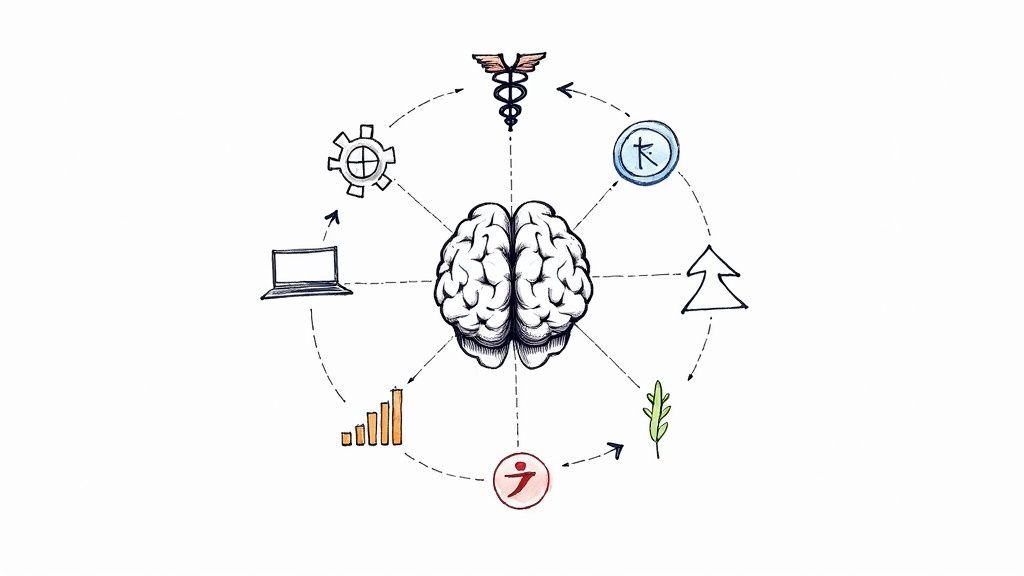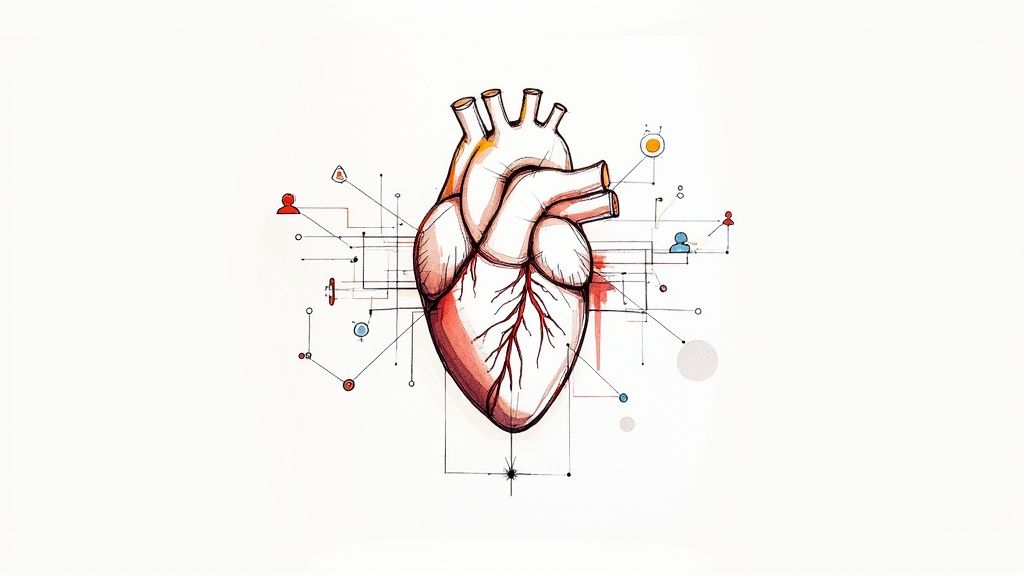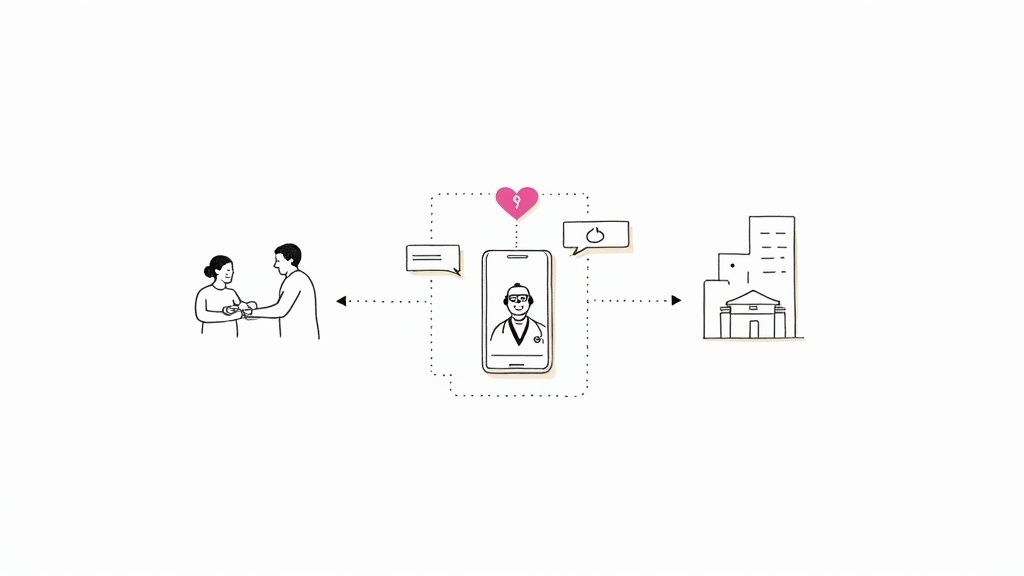Benefits of AI Co-Creation Model: Unlock Growth & Innovation
Discover the benefits of AI co-creation model and how human-AI collaboration drives innovation, efficiency, and measurable growth. Learn more now!
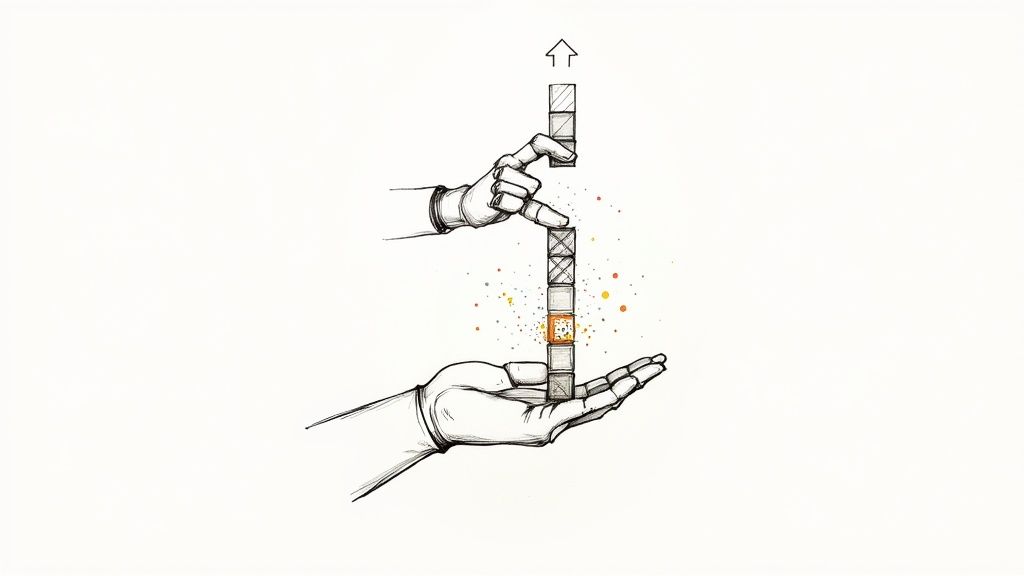
The real magic of the AI co-creation model lies in its ability to fuse human creativity with the raw processing power of machine intelligence. This creates a powerful partnership that doesn't just speed things up—it fundamentally changes how we innovate and solve problems. When this synergy clicks, AI stops being a simple tool and becomes a true collaborator, elevating human skills to deliver business value we've never seen before.
What Is the AI Co-Creation Model?
Let's cut through the jargon. At its heart, the AI co creation model is a strategic framework where human experts and artificial intelligence work together as partners.
Think of a seasoned creative director brainstorming with an AI that can generate a thousand ad concepts in a minute. The director provides the strategic vision, understands the brand's soul, and makes the final creative judgment. The AI, on the other hand, provides a massive volume of ideas and data-backed insights to spark inspiration and validate directions.
This partnership transforms AI from a simple workhorse into a collaborative peer. It’s not just about automating repetitive tasks anymore; it’s about augmentation, where AI amplifies our own abilities.
The Power of a Human-AI Partnership
The model is built on a straightforward but powerful idea: humans and AI achieve more together than either could alone. We bring intuition, ethical considerations, and a nuanced understanding of the world. AI brings incredible speed, the ability to work at an immense scale, and a capacity to analyze data sets that are simply beyond human comprehension.
When you merge these two, you get a dynamic duo where each side covers the other's weaknesses and amplifies its strengths. This back-and-forth is the key to cracking tough challenges and spotting opportunities that were previously hidden.
We're already seeing this play out in the market. The rapid consumer adoption of AI tools is a clear signal that this collaborative approach works.
This isn't just theory; the numbers prove it. By mid-2025, an estimated 1.7 to 1.8 billion people globally are expected to be using AI tools. In the U.S., over 61% of adults have already tried generative AI, with around 20% using it daily. This shows that products built on this collaborative model are not just useful—they're becoming essential. You can explore more consumer AI adoption stats.
The key difference between how businesses traditionally used AI and the co-creation model is the shift in relationship—from a tool that follows commands to a partner that contributes ideas.
Here's a quick breakdown of how these two approaches differ.
AI Co-Creation vs. Traditional AI Implementation
Aspect Traditional AI Implementation AI Co-Creation Model
Primary Role of AI
Tool for automation and execution
Partner for ideation and augmentation
Human Interaction
Humans define tasks, AI executes
Humans and AI engage in an iterative dialogue
Goal
Increase efficiency, reduce costs
Drive innovation, enhance creativity
Process Flow
Linear: Human -> AI -> Output
Cyclical: Human <-> AI <-> Iteration
Outcome
Predictable, optimized results
Novel solutions, unexpected insights
This table highlights the fundamental shift: instead of just handing off work to a machine, we're inviting it to the strategy table.
From Automation to Augmentation
This move from automation to augmentation is what gives the co-creation model its edge. Rather than just taking work off our plate, AI becomes an active contributor to the creative and strategic process. It can help with everything from the initial spark of an idea to a detailed AI requirements analysis.
This visual captures the core benefits perfectly, showing how this model creates tangible wins in efficiency, creativity, and market speed.
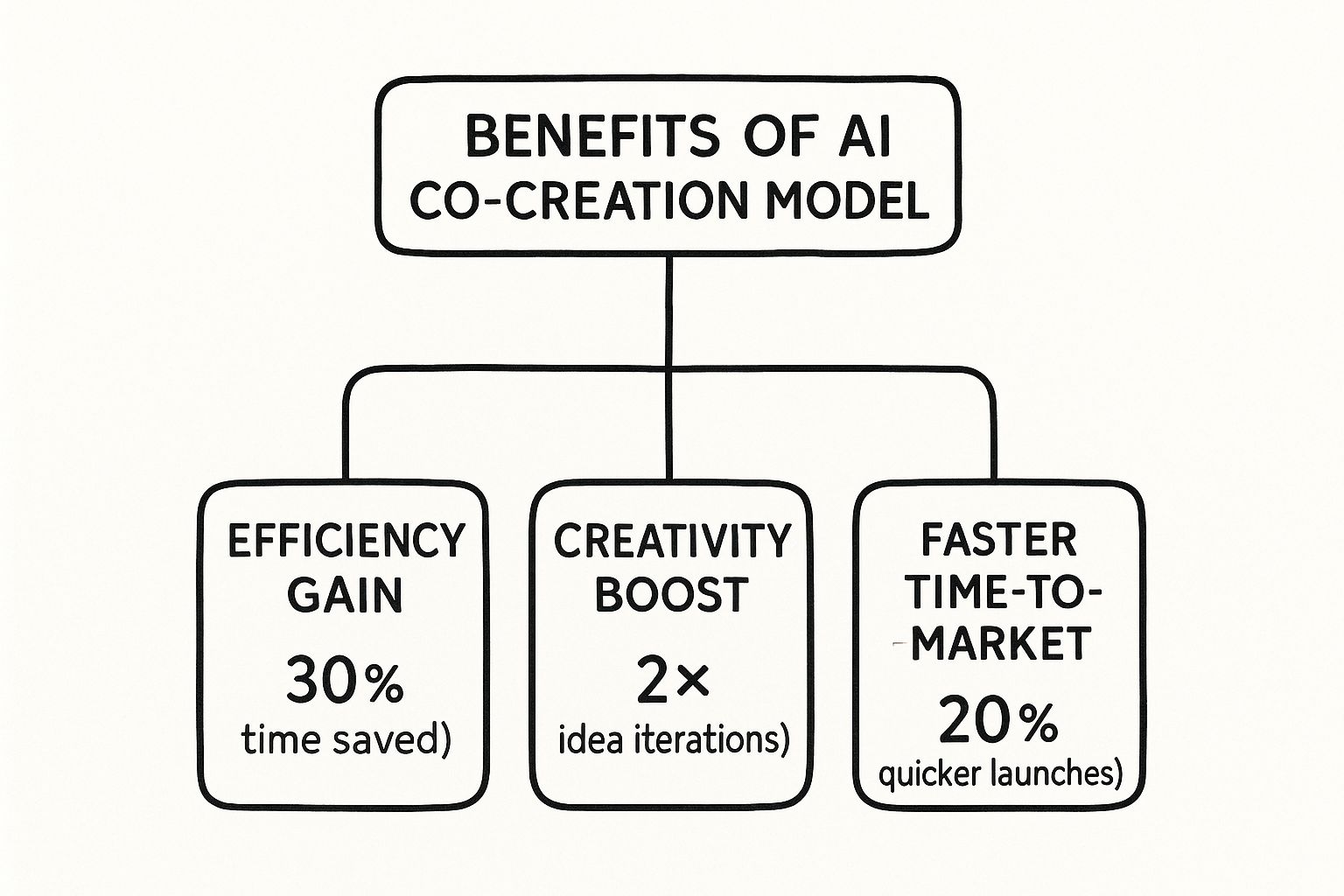
The data doesn't lie. A collaborative model directly boosts business velocity. Teams save precious time, they can explore a wider range of ideas, and they can get products out the door faster. The result is a serious competitive advantage. We'll dive into more real-world use cases that bring this to life later in the guide.
Accelerate Innovation and Business Agility
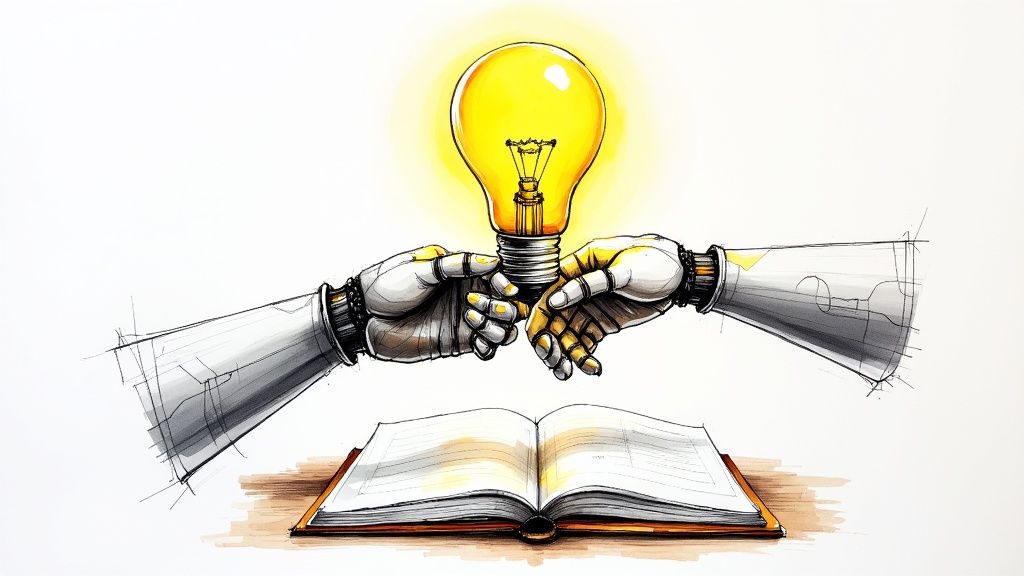
One of the biggest wins I see with the AI co-creation model is how it radically shortens the time it takes to get from an idea to a finished product. In any competitive market, speed is everything, but you can't sacrifice quality to get there. This is where the partnership between human creativity and AI muscle really shines, creating a powerful feedback loop for generating, prototyping, and testing ideas at a blistering pace.
Think about the traditional R&D process. It’s often a long, drawn-out affair: market research, internal brainstorming, a lengthy design phase, and then, finally, testing. An AI co-creation approach throws that old timeline out the window. It transforms the whole process into a nimble, iterative engine for growth.
Let's say your team is trying to figure out the next big feature for your software. The old way involved sifting through past surveys or running a few focus groups. But with an AI partner, you can analyze massive datasets in near real-time. The AI can comb through social media trends, competitor announcements, your own customer support tickets, and industry reports to find those hidden gems—the unmet needs and emerging market shifts that signal real opportunity.
From Data to Decisions at Speed
This isn't just about getting data; it's about turning that raw information into smart, actionable intelligence. An AI doesn't just hand you a spreadsheet of numbers. It spots the patterns and correlations that a human team could easily overlook, arming your strategists with the insights they need to innovate with confidence.
You’re not just moving faster; you’re making smarter, data-backed decisions every step of the way. When you bring in expert guidance, like through AI strategy consulting, you can de-risk innovation by making sure your creative ideas are anchored in what the market is actually telling you.
The real game-changer is moving from "selling to a customer to actually partnering with them." You're no longer guessing what people want. You’re building solutions alongside them, with real-time data informing every move. That kind of collaboration dramatically cuts the risk of building the wrong thing.
This newfound agility gives businesses the power to pivot almost instantly when the market throws a curveball. A competitor might launch a killer new feature, or a sudden change in consumer behavior could make your product roadmap obsolete overnight. With a co-creation model, you can analyze the new landscape, brainstorm counter-moves, and adjust your plans in days, not months.
The Iterative Innovation Loop
The AI co-creation model thrives on a continuous cycle of creation and refinement. I like to think of it as an innovation loop, where the human-AI partnership excels at each stage:
- Rapid Idea Generation: Instead of just a handful of ideas from a brainstorming meeting, an AI can spit out hundreds or even thousands of concepts based on the parameters you set. The human experts then step in to curate, combine, and refine the most promising ones.
- Instant Prototyping: AI tools can whip up mockups, wireframes, or even working code snippets in a fraction of the time it used to take. This lets your team see and play with ideas without sinking a ton of time or money into them.
- Simulated Market Testing: Before you even think about a full launch, AI can simulate how different customer groups might react to your new product. It can help predict adoption rates and flag potential sticking points, giving you a chance to fix them beforehand.
- Informed Decision-Making: All through this cycle, the human partner provides the critical context, strategic direction, and final judgment call. The AI provides the data, scale, and raw processing power to make those judgments as sharp and accurate as possible.
Of course, all this speed needs direction. That's why having a well-defined AI strategy framework is absolutely essential. It sets the guardrails and goals to ensure all this rapid iteration is actually moving you toward your business objectives. Without a solid framework, the speed of AI can just lead to chaos. With a structured approach, every cycle builds value and pushes the business forward.
Boost Your Operational Efficiency and Productivity
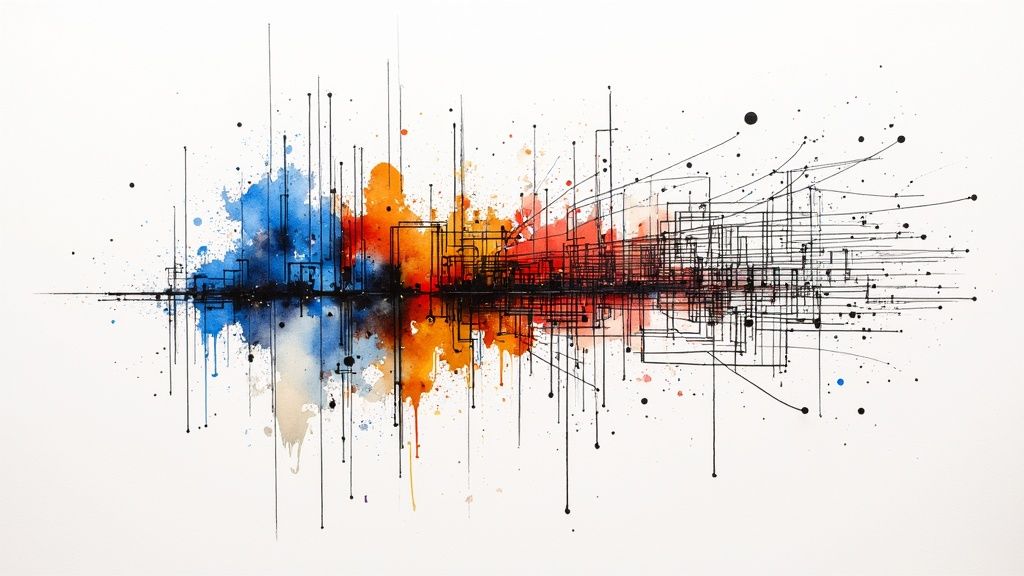
One of the most practical and immediate wins from an AI co-creation model is the impact on your company’s bottom line. We're not just talking about basic automation here. It’s about creating a true partnership between people and AI that directly tackles operational gridlock and unlocks serious productivity gains.
Think about a marketing team drowning in performance data. Instead of spending days sifting through spreadsheets, an AI partner can instantly analyze campaign metrics, spot hidden trends, and whip up performance reports. This frees up the human marketers to do what they do best: dream up brilliant creative strategies and build compelling brand stories.
This isn't just a marketing thing, either. The same idea works wonders in supply chain management. AI can take over the tedious work of tracking shipments, predicting inventory levels, and managing routine logistics. That lets your supply chain managers focus on the bigger picture, like negotiating better deals with suppliers or building a more resilient network for the future.
From Repetitive Tasks to Strategic Impact
The whole point of this collaborative model is to make your people more powerful, not to replace them. When you hand off the mind-numbing, repetitive tasks to an AI partner, you give every team member the chance to step up and be more strategic.
This partnership delivers some very real operational benefits:
- Drastically Reduces Human Error: AI is a master of precision and repetition. It minimizes the kinds of costly mistakes that inevitably creep in with manual data entry or repetitive process work.
- Wipes Out Monotonous Work: Automating the boring stuff is a huge morale booster. It reduces burnout and lets people sink their teeth into more engaging, high-value projects.
- Optimizes Entire Workflows: AI can see the forest for the trees. It analyzes your entire operational flow, spots inefficiencies a human might miss, and suggests data-backed improvements to make everything run smoother.
To get this right, you first need to know where to start. A proper AI requirements analysis is the crucial first step. Using a tool designed for this helps you pinpoint the exact bottlenecks where a human-AI team-up will give you the biggest bang for your buck.
The Measurable Impact on Business Performance
These benefits aren't just wishful thinking; they show up in the numbers. The data clearly shows that businesses adopting this model are seeing major gains in both efficiency and productivity.
A landmark 2025 Microsoft report found that 66% of CEOs are already seeing measurable business benefits from generative AI, particularly in operational efficiency. In fact, over 85% of Fortune 500 companies now use Microsoft AI to reinvent their business processes. The report also projects that every dollar invested in AI generates $4.9 in additional economic value, proving this is a core driver of business growth. You can discover more insights on AI-powered transformation in the full report.
This data tells a clear story: AI co-creation is far more than a tech upgrade. It's a strategic investment that multiplies the value and impact of your human talent.
When you bring AI into the fold as a true collaborative partner, you don't just get work done faster—you get smarter work done better. This is the shift that truly drives productivity and gives you a lasting competitive edge. To see how this could look in your own business, getting guidance from our expert team can help you map out the path forward.
How to Bring an AI Co-Creation Strategy to Life
Alright, so you see the potential of an AI co-creation model. The next question is, how do you actually make it happen? Moving from theory to practice isn’t about just flipping a switch or installing new software. It’s about cultivating a new way of working. The whole process boils down to a clear, step-by-step journey, starting with a hard look at your business needs and ending with your teams and AI working in sync.
The foundation for any successful rollout is a solid strategy framework. Think of it as your blueprint. It guides every decision, from figuring out which business problems to tackle first to choosing the right tech for the job. This is what separates random acts of AI from a focused, value-driven game plan.
A phased approach is your best friend here. You don’t need to turn the entire company upside down overnight. Instead, aim for small, measurable wins. These early victories prove the model's value and build the confidence your teams need to embrace it.
Start with a Strategic Assessment
Before you can build anything, you need to know what you’re working with. The first step is to pinpoint the exact business problems where a human-AI partnership could make the biggest difference. Don't fall into the trap of starting with the technology; start with your pain points. Are your product teams stuck in slow, frustrating innovation cycles? Is your marketing department drowning in data they can't turn into action?
Ask yourself these kinds of questions to get the ball rolling:
- Where are our biggest operational bottlenecks? Look for the processes that are slow, prone to error, or just plain tedious for your team.
- What strategic goals could AI help us reach faster? Think bigger picture—breaking into new markets, boosting customer loyalty, or diversifying your products.
- Which teams are most ready for a change? Some departments are naturally more open to new ways of working. Find those pioneers.
This discovery phase is absolutely critical. Getting this right from the start ensures your efforts are targeted where they'll have the most impact.
Build a Culture of Collaboration
Let's be clear: implementing an AI co-creation model is as much about your people as it is about the technology. True success hinges on creating a culture where employees see AI not as a replacement, but as a powerful sidekick that enhances their own skills. This means getting serious about training, communicating openly, and establishing clear ethical guidelines from the get-go.
Your leadership team has to lead the charge. When people see executives actively using and investing in AI tools and upskilling programs, it sends a clear message that this is the new way forward. Without this cultural groundwork, even the best technology will fall flat.
Research from McKinsey's 2025 global survey backs this up, showing that nearly half of organizations are already seeing real benefits from AI within specific business units. While company-wide profit boosts are still on the horizon for many, the growing investment in AI-savvy talent shows that the co-creation model is maturing. It’s directly improving how businesses operate and is starting to unlock some serious hidden value. Read more on the global state of AI from McKinsey.
This data confirms what we see in the field: the companies winning with AI are the ones investing in their people and processes, not just the tech itself.
Execute with a Phased Rollout Plan
Once you’ve figured out where to start and have begun rallying your team, it’s time to put the plan into action. A phased rollout is the smartest way to go because it lets you learn, adapt, and scale without massive risk.
- Pilot Project: Pick one high-impact but low-risk project to start. This gives your team a safe space to learn the ropes of working with AI.
- Measure and Refine: Keep a close eye on the results. Did the pilot speed things up? Was the final output better? Use these insights to tweak your approach before going bigger.
- Develop Governance: Create clear rules for data handling and ethical AI use. Everyone needs to be on the same page about how to work with AI responsibly, protecting both data and privacy.
- Scale and Integrate: Once your pilot proves successful, start rolling the model out to other teams and departments. Remember, ongoing training and support are what make the change stick.
Following these steps ensures you’re building on solid ground. If your organization needs a hand navigating this journey, getting expert AI implementation support can provide the practical guidance needed to turn your strategic vision into a day-to-day reality.
Real-World Examples of AI Co-Creation in Action

It’s one thing to talk about theory, but seeing the benefits of an AI co-creation model in the wild is where its power really hits home. This isn't just an abstract business school concept. It's a hands-on partnership that's actively reshaping how industries work, turning tough problems into genuine growth opportunities.
Let's dive into a few stories of how companies are winning by treating AI as a creative partner, not just a tool. These examples aren't about basic automation; they show what happens when human vision and machine intelligence truly team up.
Transforming Product Design and Development
Think about a design firm creating a new brand identity. The old way? A small team holes up for weeks, brainstorming a few logo concepts. With AI co-creation, that entire process gets a massive upgrade.
Instead of starting from a blank slate, a human designer provides the creative vision—the brand's personality, a specific color palette, and the desired style. The AI partner takes those cues and, in just a few minutes, generates hundreds or even thousands of unique logo variations.
Suddenly, the designer's job evolves. They're no longer just a creator; they become a strategic curator. They use their expertise to sift through the options, spot the most compelling concepts, and then apply their human touch to refine them into a final, brilliant design. The timeline gets crushed, and the creative well becomes infinitely deeper than what any human team could explore on their own.
The results are tangible and impressive:
- Faster Time-to-Market: Concepts are born and polished in a fraction of the time.
- Expanded Creativity: Designers are hit with a wave of diverse ideas, often sparking directions they never would have considered.
- Data-Backed Choices: Some AI platforms can even analyze the concepts to predict which ones will connect best with the target audience, taking much of the guesswork out of the equation.
Accelerating Scientific Discovery
The pharmaceutical world is another place where this human-AI collaboration is delivering incredible breakthroughs. Discovering a new drug is famously slow and expensive—we're talking over a decade and billions of dollars. AI co-creation is helping to change that.
Picture a team of researchers trying to find a new cancer treatment. They partner with an AI that can comb through immense databases of molecular structures, genetic data, and past clinical trial results. The researchers provide the critical scientific context and hypotheses, essentially aiming the AI's powerful analytical lens.
The AI then does the heavy lifting, identifying potential drug candidates and predicting their effectiveness and side effects at a speed no human could match. This lets the scientists focus their lab work on the most viable compounds, cutting out years of trial and error. It's a perfect example of how an AI strategy framework can be applied to solve some of humanity's biggest challenges.
This shift from selling a product to a customer to actually partnering with them is a powerful one. When you invite the customer—or in this case, the data—into the creative process, you uncover solutions you wouldn't have found through standard methods. The solution becomes sharper and more likely to succeed because it's built on a foundation of deep, collaborative insight.
These real-world use cases offer a clear look into a future where human ingenuity is amplified, not replaced. From the creative arts to life-saving science, the co-creation model is proving itself to be a powerful engine for progress. As our expert team has seen time and again, the magic happens when you find that perfect blend of human strategy and machine intelligence.
So, What's Next on Your AI Journey?
We've walked through the ins and outs of the AI co-creation model, and it's clear this isn't some far-off idea pulled from science fiction. This is a real-world strategy that gives businesses a serious competitive edge, right now. We've moved beyond the hype to show how this human-machine partnership delivers tangible results—boosting efficiency, sparking genuine innovation, and sharpening your entire operation.
But let's be honest, going from understanding a concept to actually putting it into practice is where the real work begins. Making the switch to AI co-creation is a major business decision, but it's one that pays off. It gives your teams new superpowers, helps you create far better customer experiences, and builds a solid foundation for growth that lasts.
From "What If" to "What's Next"
Knowing the benefits is great, but acting on that knowledge is what creates real value. The path forward isn’t about just flipping a switch; it requires a thoughtful, structured approach. You have to start by pinpointing the specific business headaches where AI collaboration can make the biggest difference, and then work on building a culture that truly embraces this new way of working together.
To make this transition stick, you'll need a few key things in place:
- A Clear Vision: First things first, what do you actually want to achieve with AI? Getting this down on paper will be your North Star through the entire process.
- The Right Tools: You need technology that’s built for teamwork. This means finding the right platforms for everything from an AI requirements analysis to keeping projects on track.
- Expert Guidance: Let’s face it, navigating this shift is tricky. Partnering with specialists in AI strategy consulting helps you sidestep common mistakes and get where you're going, faster.
Adopting a co-creation model isn't just a tech upgrade; it's a fundamental shift in how your business thinks. You move from just checking off tasks to solving complex problems alongside a powerful new partner. This change creates a more agile, creative, and resilient organization that's ready for whatever comes next.
Ready to Start Your Transformation?
Taking the first step can feel like a huge leap, but you don't have to go it alone. The key is to begin with a solid plan that’s built specifically for your business. As we explored in our AI adoption guide, a well-thought-out strategy is the foundation for everything else. A smart AI strategy framework will map out your journey, from the initial "what do we need?" phase all the way to full integration, making sure every move you make pushes you closer to your main goals.
If you're ready to build an AI strategy that fits your company like a glove and unlock what human-machine collaboration can really do, we'd love to talk. Connect with our expert team today. We have the hands-on experience to guide you in crafting a plan that turns the promise of AI into real, measurable results for your business.
Frequently Asked Questions
It's completely normal to have questions when you're thinking about bringing an AI partner into the mix. Let's walk through some of the most common ones that come up as teams start exploring this new way of working.
What Is the Difference Between AI Automation and AI Co-Creation?
This is a great question, and the distinction is crucial.
Think of AI automation like a super-smart, programmable robot on an assembly line. You give it a very specific, repetitive job—like sorting customer support tickets or running payroll calculations—and it executes it flawlessly, over and over. The goal here is pure efficiency, getting mundane work off your team's plate.
AI co-creation, on the other hand, is like having an expert collaborator join your brainstorming session. Instead of just taking on a task, the AI actively contributes to the creative and strategic process. It can help you generate a flood of new ideas, spot patterns you might have missed, or even draft initial versions of a new design.
Automation is about doing. Co-creation is about thinking, discovering, and creating together.
How Can Small Businesses Benefit from an AI Co-Creation Model?
This is where things get really exciting. AI co-creation can be a huge game-changer for small businesses. You might not have the massive R&D budget of a Fortune 500 company, but an AI partner can give you access to a similar level of analytical horsepower and creative scale.
Imagine you run a small e-commerce shop. You could team up with an AI Strategy consulting tool to analyze real-time market trends and co-design a new product line that perfectly hits what customers are looking for. Or, if you're a boutique marketing agency, you could work with an AI to generate a hundred different ad campaign concepts for a new client, allowing your small team to punch way above its weight.
It really does level the playing field, helping smaller companies innovate faster and compete with much larger players.
What Are the First Steps to Building a Supportive Culture?
You can't just drop new technology into a company and expect it to work. Building a culture that truly embraces AI co-creation starts with open and honest communication, especially from leadership. The key is to frame AI as a tool that amplifies human talent, not something that's coming to replace people.
Here are a few practical first steps:
- Start with the "Why": Be crystal clear about the vision. Explain how this partnership will help the business thrive and, just as importantly, make your employees' jobs more engaging and valuable.
- Invest in Your People: Don’t just give them a new login. Offer hands-on workshops and easy-to-access resources that demystify the technology. The goal is to build confidence and comfort.
- Launch a Pilot Project: Pick one small, low-risk project to test out the co-creation model. A win here will create powerful internal advocates and build the momentum you need for broader adoption.
The single most important thing is to create an environment where people feel safe to experiment and feel heard. When your team sees their own feedback shaping how AI is used, they become genuine partners in its success. That shared ownership is the bedrock of a real co-creation culture.
How Do You Measure the ROI of an AI Co-Creation Initiative?
Measuring the return on an AI co-creation initiative requires looking beyond simple cost savings. Yes, efficiency gains are part of the story, but the real value often lies in metrics tied directly to innovation and growth.
You'll want to track things like:
- Speed to Market: How much faster are you getting new products, services, or features out the door?
- Innovation Rate: Are you generating more high-quality ideas? Are more of your prototypes turning into successful launches?
- Employee Engagement: Are teams reporting higher job satisfaction now that they can focus on more strategic work?
- Customer Satisfaction: Are the products you co-create with AI leading to better reviews and stronger customer loyalty?
Tracking these kinds of KPIs will give you a much richer, more accurate picture of the total value you're creating. For more detailed answers, you can also check out our dedicated FAQ page.
Ready to move from questions to action and start building your AI-powered future? At Ekipa AI, we help you turn strategy into reality. Discover how our platform can tailor an AI transformation plan for your business in just 24 hours.

